#Arnedo
Explore tagged Tumblr posts
Text
Talleres Valle: tu taller mecánico en Arnedo de confianza
Talleres Valle Arnedo
Mecánica, neumáticos, chapa y pintura y venta de coches. Mecánicos con experiencia y profesionalidad a tu servicio
En Talleres Valle nos comprometemos a ofrecerte los mejores servicios para el cuidado y mantenimiento de tu vehículo en Arnedo. Con años de experiencia, nuestro taller ofrece atención especializada en mecánica, electricidad, chapa y pintura, neumáticos y venta de vehículos. ¡Te aseguramos la mejor calidad y precio!

1 note
·
View note
Text
Viejos pins (125)
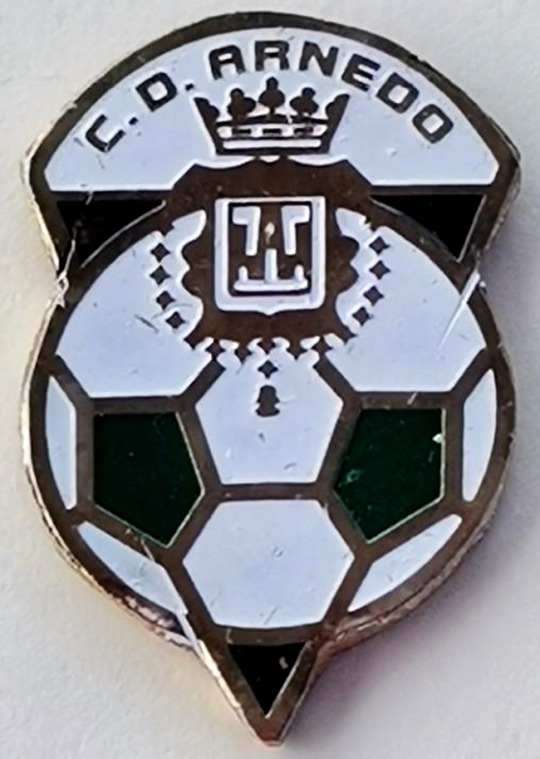
Hoy le toca a los riojanos del Club Deportivo Arnedo, fundados en la localidad homónima en 1949. En sus primero años el club vestía de azulgrana, que más tarde cambiaría por el blanco actual, y tenía su sede social en la en el café bar España.
El lema del club es Un pueblo, un equipo, una ilusión y ha logrado estar tres temporadas en la extinta Segunda B.
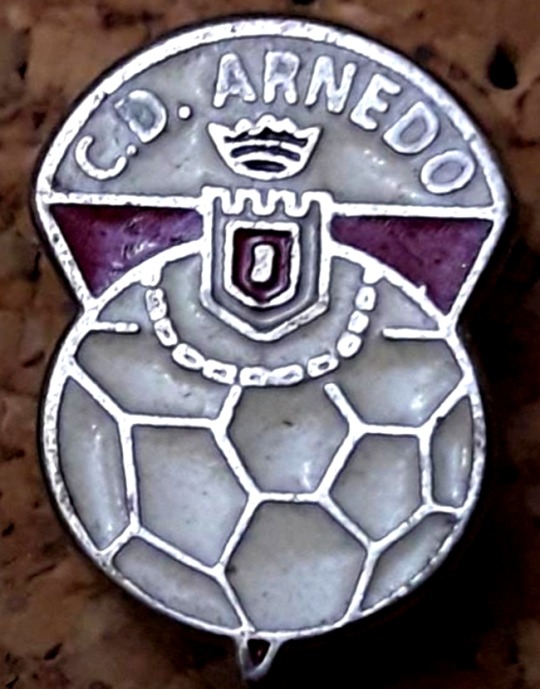
0 notes
Text
Arnedo : Décevante corrida de Alcurrucen, Talavante pour sauver la tarde
Compte rendu de la corrida de Arnedo
A Arnedo, la traditionnelle corrida de la Féria de San José s’est déroulée dans des arènes combles. Le torero local Diego Urdiales était entouré des deux figuras Morante de la Puebla et Alejandro Talavante. Malgré une terna attractive, les toros de Alcurrucen ont gâché la fête puisque le lot envoyé par la famille Lozano a totalement manqué de race dans son ensemble. Seul Alejandro Talavante est…
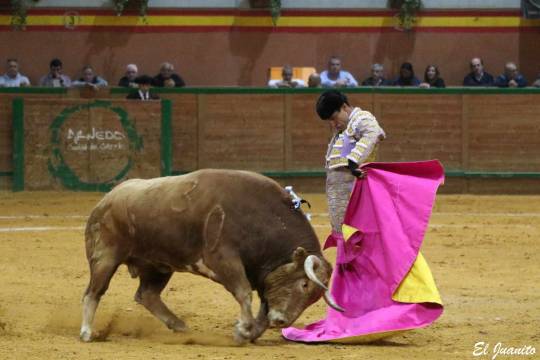
View On WordPress
0 notes
Text

Ainhoa Larretxi by © Sol Arnedo Garbisu
35 notes
·
View notes
Text
Cada vez nos sentimos más jóvenes de lo que realmente somos, y eso es una excelente noticia
Cada vez más personas declaran tener una edad subjetiva inferior a la que marca su fecha de nacimiento. Según las últimas investigaciones, este sentimiento comporta numerosos beneficios en la salud. Por Iván Santolalla Arnedo Ground Picture / Shutterstock ¿Que cuántos años tengo? / ¡Qué importa eso! / ¡Tengo la edad que quiero y siento! / Pero no es la edad que tengo, ni lo que la gente dice, /…

View On WordPress
#Autor Iván Santolalla Arnedo#Beneficios saludables#Edad subjetiva#Envejecimiento activo#Envejecimiento saludable#The Conversation
1 note
·
View note
Text
The Soviet Revolution of October 1934
The Second Spanish Republic is a figure in history which tends to be overly glorified by the contemporary Spanish left, including some excessively folklorist communists, as a desire to look through history for any instance when opposition to the monarchy and reactionaries was the hegemonic position. After 40 years of a fascist dictatorship, and 46 years of a liberal democracy that has exposed social-democracy's bankruptcy, the Second Republic is a time when the PCE (Communist Party of Spain) was a force to be reckoned with, at least compared to today, with a few hundred thousands along its lines. Despite the Second Republic lasting from 1931 to 1936, the aspects that tend to be glorified are the times of the Popular Front, the electoral alliance from the PSOE to the PCE that won the February 1936 elections, and ruled until the coup d'etat of July 1936. Perhaps unconsciously, perhaps consciously, the years of 1932-1935 tend to be not forgotten, but minimized.
This is because the Second Republic was not a "popular" state, it wasn't even nominally progressive for half its history. And again, in an exercise of willful ignorance, when its repressive episodes are discussed, most tend to focus on the Black Biennium, as historiography knows it, the two years (1933-1935) when the right governed under the CEDA coalition, which included falangists, monarchists, even Carlists. But the history of repression in the Second Republic begins not even a month after its constitution was ratified. The Castiblanco incidents of December 1931 saw a few day workers killed by the police during a peaceful demonstration asking for work, afterwards it turned violent and 4 policemen were lynched by the workers. That same week, in the Arnedo incidents, the 5th of January 1932, the police shot into a crowd of striking workers in the town's square, renamed recently to Republic Square. 11 people were killed, two of them a mother and his 4 year old son, another a 70 year old woman. 5 others were permanently left unable to work. Just a year later, in January of 1933, 19 men, 2 women and a child were massacred in the Casas Viejas Incident, after an attempted uprising and occupation of the police quarters.

The Second Republic was always an anti-worker state, from its very beginnings. Regardless of what its constitution said, the social advances of the republic were lubricated with worker's blood.
Let's set some context for the subject of this post: The PCE, section of the Third International, found itself at risk of dissappearence at the end of the 1923-1930 dictatorship. It only really began to recover after José Diaz was elected General Secretary in 1932, it had about 1.000 members at this time, and by 1934 it had risen to 15.000 members, without counting the members of its youth wing. Internationally, the meteoric rise of fascism was unignorable. Nazi-fascism and fascism had seized power in Germany and Italy, and similar tendencies in Portugal and Austria were also in power, in the form of Salazar's Estado Novo in the former and Dollfuß' austrofascism in the latter, himself killed by outright nazi-fascists. Spain had its supposedly progressive Republic, of course, but it did not prevent the JONS to be founded in 1931 and the Falange in 1932, which during the civil war would merge into the infamous FE de las JONS, the Spanish Falange of the National-Syndicalist Offensive Juntas (The Falange is still a legal party now!). The leader of the CEDA, which would later govern during that Black Biennium I mentioned earlier, attended the Nürnberg Congess of 1932, where the pictures of those massive nazi-fascist rallies come from.
The 4th of October, 1934, 3 CEDA ministers had been chosen to enter the government, and in response, a strike, called the Revolutionary General Strike, was called for the following day, the 5th of October, 90 years ago today. The organization of this strike was done between the PCE, CNT (national confederation of workers, an anarcho-syndicalist union) and PSOE. The will to call the strike was not equal, however. The meeting minutes of the evening and night of the 4th show that the CNT was not very convinced of the strike and flip-flopped a lot, while the PSOE only decided to support the strike once it became impossible for them not to. The PCE, on the other hand, had already spent a few months warning of this, and preparing.
Barely a month before October, the police found a shipment of weapons going from the port of Gijón to Mieres, the future epicenter of the revolution. There were three armed shipments, and while the other two reached their destination, the third one being found almost lead to Indalecio Prieto, of the PSOE, being arrested. As a result, the weapon stashes in various places in Madrid (Casa del Pueblo, Ciudad Universitaria, Cuatro Caminos). These weapon stashes were supposed to supply the revolutionary strike in Madrid, and since they were found, the nascent revolutionary center was stillborn, since it was unable to arm itself. These same weapon stashes would later be replenished and used by the first militias of Madrid in the July 1936 coup d'etat
Nevertheless, the call for a strike was distributed at 6:00 of the 5th, but it was only heeded in Asturias, Madrid, Vizcaya, Cataluña, plus a few weak points (Cantabria, Aragón, Alicante, León, Palencia, Málaga). The reason the call was not heeded in broader parts of the country was because the agricultural day workers, predominant throughout the central meseta and south had already carried out their own strike that same year. They were recovering, they feared the repression that was still fresh in their minds, and it did not help that the predominant political organization among them, the CNT, took too long to support the strike, they simply were not prepared. It is impossible to understate how crucial this point is. The greatest worker strata in Spain were unable to be reached by the call to a revolutionary strike, for reasons related to the situation, but because of the inability of the PCE of this time to truly penetrate the social majority.
At any rate, the Revolutionary General Strike was not ignored everywhere, from these days comes this picture of Madrid's very center devoid of people, withholding their work, but impotent to do anything more:
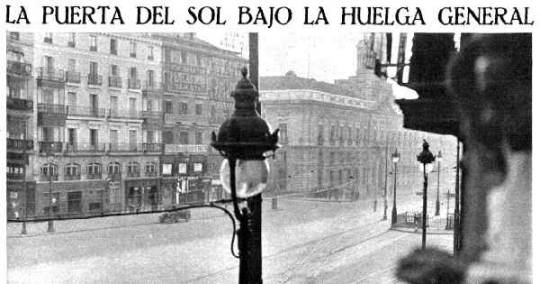
The Second Republic did not hesitate to stifle this strike, using planes and naval and land artillery. Once again, Spanish capital required trails of this country's reddest blood to line the streets, not shying away from employing the help of fascists such as the up-and-coming General Franco, sent to repress the workers of Asturias, where the strike was incandescent with revolutionary impetus. Before talking about Asturias, I won't ignore the other places where the strike was also popular. In Guipúzcoa and Vizcaya, The Basque Country, repression was just as bloody, executed by the Guardias de Asalto (Assault Guards), killing 40 workers in Vizcaya. There, the "Revolutionary Committee of Vizcaya", led by the UGT, was quickly dissolved. In Cataluña, a Catalan state was quickly declared, lead by the bourgeois Esquerra Republicana de Catalunya (Catalonian Republican Left), but was just as quickly put down with another 40 dead.
Asturias is another story, one that lasted for two weeks. It isn't much, but in those two weeks, the Spanish proletariat came the closest to holding political power, closer than any other time in its history. There, the strike did have a pre-existing entity capable of organizing the strike: the Worker and Peasant Alliance formed the 1st of April of that year, an armed force influenced by UGT, CNT (only present in the Asturias alliance), the Asturian Socialist Federation, and the PCE, whose militants often represented the most advanced elements of these alliances, but simultaneously relatively few. These alliances were heavily inspired by the Soviets, and often talked about the Sovietization of industry and of opposing colonialism. While this is evidence that it really was an attempted revolution, and that they were inspired by the Bolshevik revolution, their attempt to imitate the USSR's Soviets instead of learning from them was one of the many factors that provoked its defeat. Despite the name, the Worker and Peasant alliances were never as strong among peasants, not a lot of effort was put into it.
Another organization that was relevant during the October Revolutionary Strike were the Workers and Peasant's Antifascist Militias (MAOC in Spanish), a paramilitary militia, founded by Antonio Modesto, a member of the PCE educated in the USSR, he'd later become famous within the republican side of the Civil war. These militias were few but competent, they counted 150 members in Madrid and Asturias each, and while the Asturias militias participated in the revolution, the ones in Madrid sabotaged the roads and railways leading north, to avoid reinforcements getting to Asturias. These militias would later be the base from which the Fifth Regiment was created, in July 1936, to commence the defense of Madrid from the coup d'etat and fascist assault.
In Asturias itself, the proletariat lunged forwards as fast as it could, growing from the town of Mieres and the Nalón basin, to every other mining basin, taking the cities of Oviedo and Gijón by force. The National Guard's many stations were occupied and raided for arms and ammunition, they already had access to explosives from mining equipment. At one point, they felt strong enough to consider a march on Madrid, and even proclaimed the Asturian Socialist Republic. In what sometimes was called the Asturian Commune, a reference to the Paris Commune of 1871, production was controlled by workers, protected by a combatant force of up to 30.000 strong. Production in the metallurgical and mining industry was organized through attempts at imitation of the Soviets, as I mentioned. The Asturias branch of the Central Bank of Spain was expropriated as well, substituting money for a system based on coupon-like vouchers. However, the Revolutionary Committee leading the revolution was dissolved and reformed 2 times in those weeks, without counting the third dissolution that came with capitulation, although that committee did begin to plan the region's economy, the short span of time not really being enough to judge its efficiency.
The revolutionaries' retreat only began once the Republican government, as anti-worker as ever, followed the advice of generals Franco and Godet to deploy the Tercios de Regulares and the African Legion, two battle-hardened groups of the military not afraid to be brutal against the workers. While they advanced, for instance, they executed every wounded solider or civilian found in captured hospitals. In Asturias, more than a thousand workers were killed in combat or executed, and in total throughout Spain, the strike concluded with 2.000 dead, 7.000 wounded, and 40.000 imprisoned, for the crime and sin of daring to govern oneself and to end the exploitation of man by man. One of these dead workers stands out among the rest in popular culture nowadays, a member of the PCE's youth wing: Aida de la Fuente. She was only 19 when she joined the revolution in motion, the daughter of the PCE's founder in Oviedo, and she was known to be an exceptionally brave and dedicated communist. The 13th of October, a few hours after being seen distributing leaflets to civilians urging them to join the revolution, she found herself almost alone in Oviedo, trying to hold off the Legion's advance by manning a machine gun, and she managed to do so for a few hours. She was reached nevertheless and when a Legion commander asked her to surrender, she only responded by shooting back. Seconds later she was killed, and later found in a common grave. The counter-revolutionary press attempted to paint her murder as one committed by her own comrades, even claiming rape, but this was disproved by a journalist who risked his own life, and the testimony of the very legionary who executed Asturias' reddest rose.

The Asturias revolution was, for all its merits and promise, a stillborn revolution. The Communist Party did not have effective direction over the mass of proletarians involved in the revolution, let alone the even greater mass who, for one reason or another, did not meet the conditions necessary for attempting to seize power. The strike's organization was insufficient and thwarted in part, and militarily, the objective Indalecio Prieto was tasked with of securing support among the military officials, along with the general inferiority of the Asturian revolutionaries compared with the elite bodies of the military, meant there was no realistic chance of success. The strike was not even fully effective within Asturias, for instance, the livestock peasants known as vaqueiros, of the southwest, did not ever really have their influence. The PSOE militants who did exist in the region got into trucks and left for Oviedo, while a column of revolutionaries from León, the other side of the mountain range, tried to take Cangas del Narcea, the main town of the region, but they were routed by the National Guard.
After the defeat, 121 revolutionaries exiled themselves to the USSR, mostly communists but also accompanied by a handful of anarchists. There, they received education as cadres, who later returned to Spain before and during the civil war, providing invaluable expertise. Others chose to exile in Portugal or France, but both those countries repatriated them to be imprisoned in Spain.
During the negotiations between the Popular Front and the PCE for the 1936 elections, the main requisite they demanded in order to join was the amnisty of these tens of thousands of imprisoned workers, from the October Revolution and from the myriad of episodes of repression during the Black Biennium. To achieve this amnisty, they were also helped by International Red Aid, a political Red Cross founded by the International in 1922. They, along with the PCE, also provided a pension for the families of the many imprisoned. During the civil war, the Red Aid played an important role in the republican side's medical centers.
This episode is often forgotten when talking about the civil war, but it was one of the many reasons fascists were allowed to take power. Spain's risk of sovietization was an internationally recognized risk, so when the opportunity came, Spanish, English, French, and US capital very gladly did everything they could to hamper the Republic
The lesson from the October Revolution of 1934 is clear. Without country-wide preparation, without a proper analysis of your own conditions, and without achieving social alliances, any revolutionary struggle is bound to fail. The lack of support in the much greater agricultural areas, the rushed planning and failed planning everywhere but Asturias, partially, the PCE's still weak influence in most organizations or regions, all of this meant that, whatever the Spanish proletariat learnt in that Revolutionary General Strike, was bound to be written in sweat and blood. The point of commemorating this bittersweet memory is not to dwell on what could have been, nor to recreate the MAOCs. It's to remember that a revolution is always a couple of bad decades away, and that not building consciousness and preparing structures for it will only mean more unnecessarily murdered workers. It's to ensure that, next time red October is around the corner, it will not be premature. The strength of the working class, our class, the social majority, lies not in the number of victories and defeats, but in the very fact of our fight, explicit and implicit. It lies in the fact that, for as long as classes based on exploitation exist, class conflict is unavoidable.
Many political forces nowadays, which one might call opportunist, will try to draw parallels between that autumn of 1934 and today, exhorting "unity of the left". The only unity that's truly revolutionary, the only unity that will not cause the subordination of our class interests to electoral or immediatist growth objectives, is the unity of the entire working class under a single Communist Party. The PSOE, even with its very involved marxist wing, characterized by the likes of Largo Caballero or Indalecio Prieto, only ever concieved of the Revolutionary General Strike as a means to the end of preventing those CEDA ministers from being appointed and in turn, gain more electoral and institutional strength. They also happened to be a relevant force because of their sheer number of members.
98 notes
·
View notes
Text
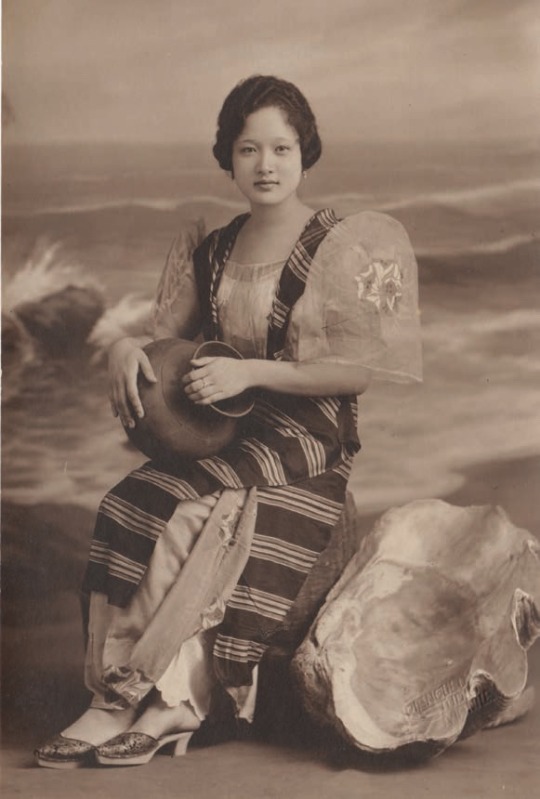
“Elisa Juana Espiritu Arnedo in a balintawak, circa 1930s.
postcard photo by Triangulo Studio (Manila), 13.5 x 8.5 cm.
Collection of Augusto Gonzalez III”
16 notes
·
View notes
Text
12th part of the bookscans of Al Andalus. Historical Figures, here's the previous part
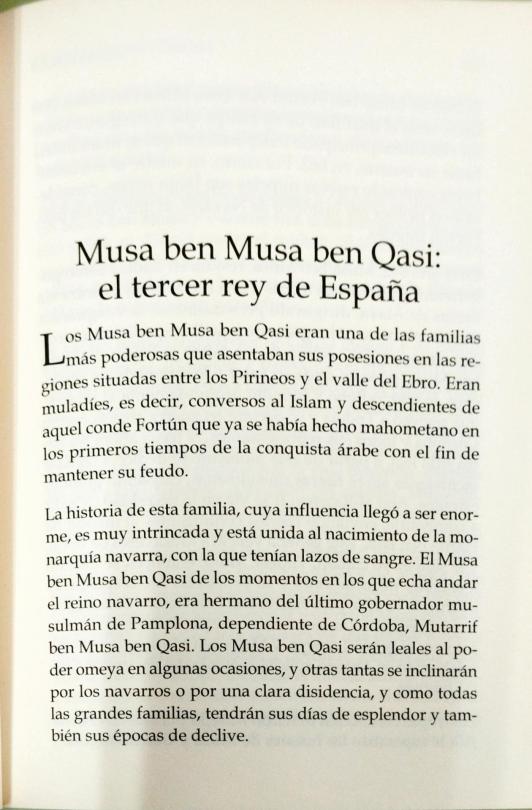
Musa ben Musa ben Qasi: the third king of Spain
The Qasi were one of the most powerful families that established their possessions in the regions located between the Pyrenees and the valley of the Ebro. They were muladíes, that is, converts to Islam and descendants of that count Fortún who had already become a Mohammedan in the early days of the Arab conquest in order to maintain his fiefdom.
The history of this family, whose influence became enormous, is very intricate and it is linked to the birth of the Navarrese monarchy, with which they had blood ties. The Musa ben Musa ben Qasi of the moments in which the Navarrese kingdom begins to move , he was brother of the last Muslim governor of Pamplona, dependent of Córdoba, Mutarrif ben Musa ben Qasi. The Qasis will be loyal to the Umayyad power on some occasions, and on many other occasions they will lean towards the Navarrese or a clear dissidence, and like all great families, they will have their days of splendor and also its times of decline.
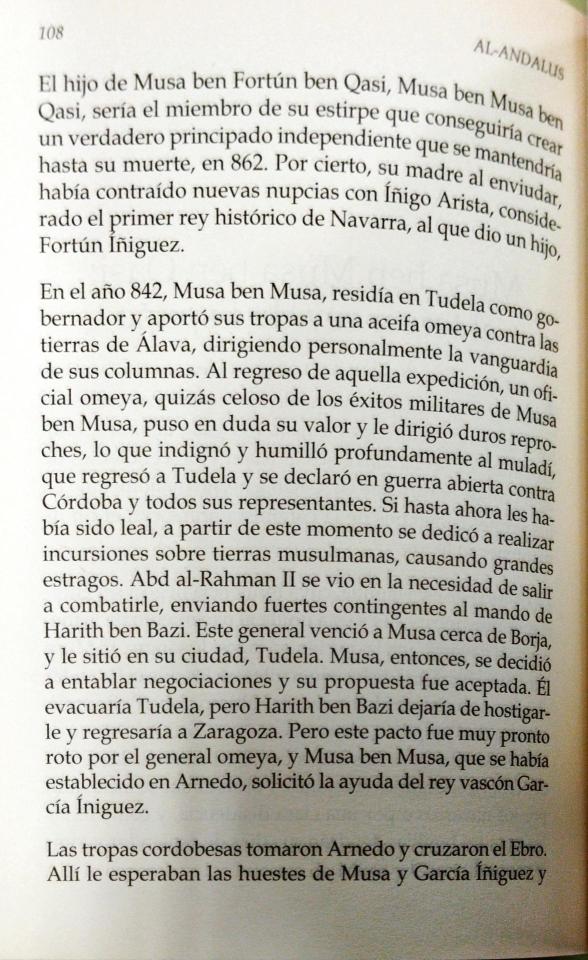
The son of Musa ben Fortún ben Qasi, Musa ben Musa ben Qasi, would be the member of his lineage who would create a true independent principality that would remain until his death, in 862. By the way, when his mother was widowed, she had remarried with Eneko Aritza, considered the first historical king of Navarra, to whom she gave a son, Fortún Íñiguez.
In the year 842, Musa ben Musa, resided in Tudela as governor and contributed his troops to an Umayyad olive tree against the lands of Álava, directing personally the vanguard of his columns. Upon return from that expedition, an Umayyad officer, perhaps jealous of the military successes of Musa ben Musa questioned his courage and reproached him harshly, which outraged and deeply humiliated the muladí, who returned to Tudela and declared opened war against Córdoba and all its representatives. If until now there had been loyal, from this moment on he dedicated himself to carrying out raids on Muslims lands, causing great havoc. Abd al-Rahman II was seen in the need to go out to fight him, sending strong contingents under the command of Harith ben Bazi. This general defeated Musa near Borja, and besieged him in his city, Tudela. Musa then decided to start negotiations and his proposal was accepted. He would evacuate Tudela, but Harith ben Bazi would stop harass him and he would return to Zaragoza. But this pact was soon broken by the Umayyad general, and Musa ben Musa, who had settled in Arnedo, requested the help of the Basque king García Íniguez.
The Cordoban troops took Arnedo and crossed the Ebro. There the soldiers were waiting for the hosts of Musa and García Íñiguez and
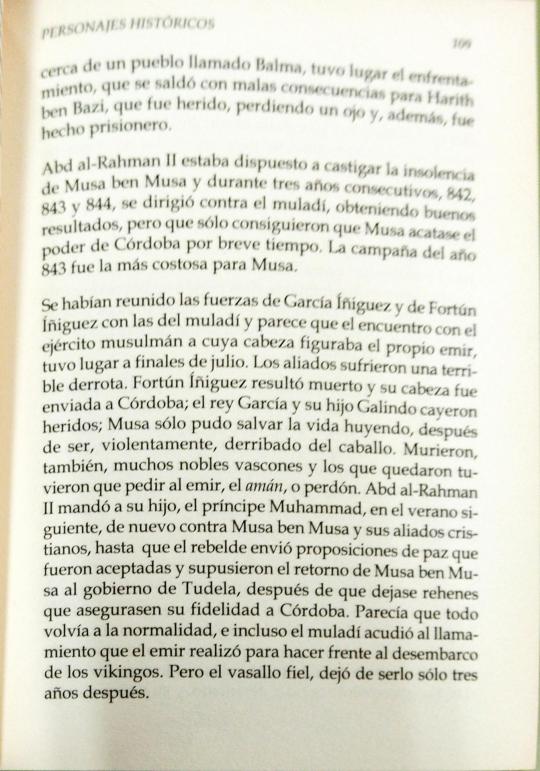
near a town called Balma, the confrontation took place, which ended with bad consequences for Harith ben Bazi, who was wounded, losing an eye and, furthermore, he was taken prisoner.
Abd al-Rahman II was ready to punish the insolence of Musa ben Musa and for three consecutive years, 842, 843 and 844, he went against the muladí, obtaining good results, but they only managed to get Musa to comply with the power of Córdoba for a short time. The campaign of the year 843 was the most costly for Musa.
The forces of García Íñiguez and Fortún Íñiguez had met with those of the muladí and it seems that the encounter with the Muslim army whose head was the emir himself, took place at the end of July. The allies suffered a terrible defeat. Fortún Íñiguez was killed and his head was sent to Córdoba; the king García and his son Galindo were wounded; Musa could only save his life by fleeing, after being violently knocked off his horse. Many also died. Basque nobles and those who remained had to ask the emir, the haman, for forgiveness. Abd al-Rahman II sent his son, Prince Muhammad, in the following summer, again against Musa ben Musa and his Christian allies, until the rebel sent peace proposals that were accepted and led to the return of Musa ben Musa to the government of Tudela, after he left hostages who ensured their loyalty to Córdoba. It seemed that everything was returning to normal, and even the muladí responded to the call that the emir made to face the landing of the Vikings. But the faithful vassal ceased to be so for only three years after.
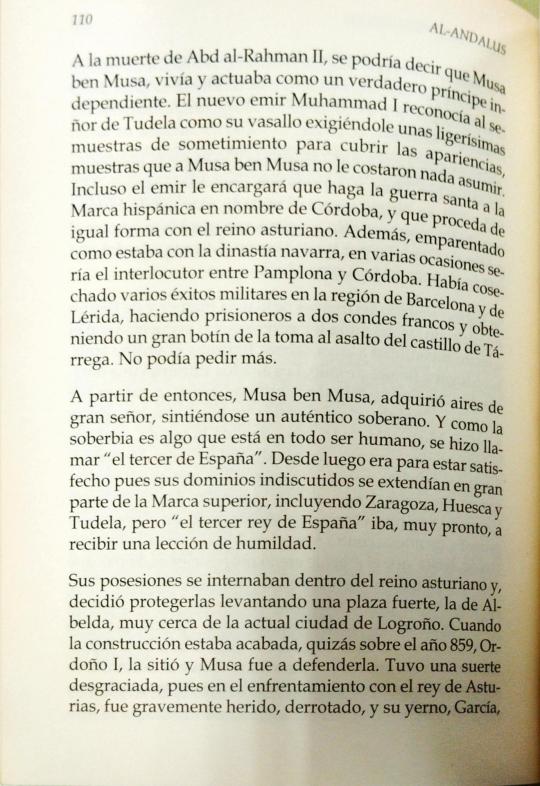
At the death of Abd al-Rahman II, it could be said that Musa ben Musa lived and acted like a true independent prince. The new emir Muhammad I recognized the lord of Tudela as his vassal, demanding some very light signs of submission to cover appearances, signs that Musa ben Musa's benefits did not cost him anything to assume. Even the emir will commission him to wage holy war to the Hispanic March in the name of Córdoba, and to proceed in the same way with the Asturian kingdom. Furthermore, related as he was to the Navarrese dynasty, on several occasions he would be the interlocutor between Pamplona and Córdoba. He had achieved several military successes in the region of Barcelona and Lérida, making taking two Frankish counts prisoners and obtaining great loot from the assault of the Tárrega castle. He couldn't ask for more.
From then on, Musa ben Musa acquired the air of a great lord, feeling like a authentic sovereign. And since pride is something that is in every human being, he is called "the third of Spain". Of course it was to be satisfied because his undisputed dominions extended over much of the Upper March, including Zaragoza, Huesca and Tudela, but "the third king of Spain" was going, very soon, to receive a lesson in humility.
His possessions were located within the Asturian kingdom and he decided to protect them, building a stronghold, that of Albelda, very close to the current city of Logroño. When the construction was finished, perhaps around the year 859, Ordoño I, besieged it and Musa went to defend it. He had unfortunate luck, because inbconfrontation with the king of Asturias, he was seriously wounded, defeated, and his son-in-law, Garcia,
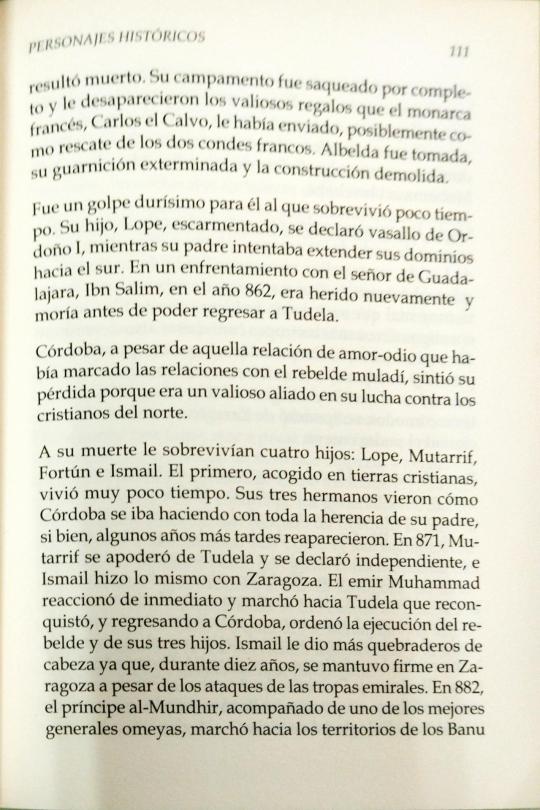
was killed. His camp was completely looted and the valuable gifts that the French monarch, Charles the Bald, had sent him disappeared, possibly as a ransom for the two Frankish counts. Albelda was taken, its garrison exterminated and construction demolished.
It was a very hard blow for him that he survived for a short time. His son, Lope, chastened, he declared himself a vassal of Ordoño l, while his father tried extend their domains to the south. In a confrontation with the lord of Guadalajara, Ibn Salim, in the year 862, he was wounded again and died before he could return to Tudela.
Córdoba, despite that love-hate relationship that had marked the relations with the muladí rebel, he felt his loss because he was a valuable ally in his fight against the Christians of the north.
At his death he was survived by four children: Lope, Mutarrif, Fortún and Ismail. First, welcomed to Christian lands, he lived for a very short time. His three brothers saw how Córdoba was taking over his father's entire inheritance, although a few more years afternoons they reappeared. In 871, Mutarrif seized Tudela and declared himself independent, and Ismail did the same with Zaragoza. Emir Muhammad reacted immediately and marched towards Tudela which he reconquered, and returning to Córdoba, he ordered the execution of the rebel and his three sons. Ismail gave him more headaches since, for ten years, he stood firm in Zaragoza despite the attacks by emiral troops. In 882, prince al-Mundhir, accompanied by one of the best Umayyad generals, marched towards the territories of the Banu
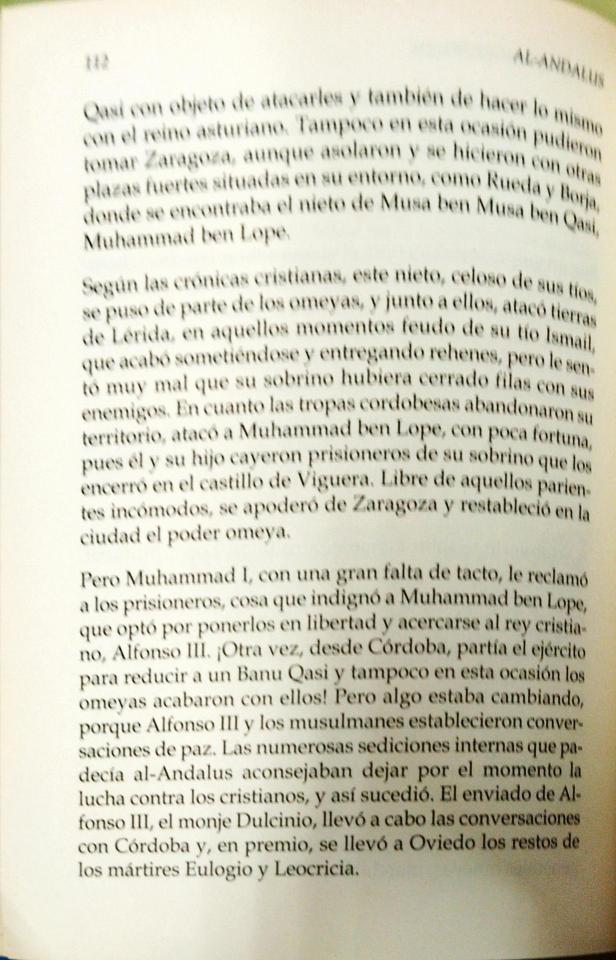
Qasi in order to attack them and also to do the same with the Asturian kingdom. Neither on this occasion could they take Zaragoza, although devastated other places located in their surroundings, such as Rueda and Borja, where Musa ben Musa ben Qasi's grandson is found, Muhammad ben Lope.
According to Christian chronicles, this grandson, jealous of his uncles, took side with the Umayyads, and together with them, he attacked the lands of Lleida, at that time a fiefdom of his uncle lsmail, who ended up submitting and handing over hostages, but he disliked that his nephew had closed ranks with his enemies. As for the Cordoban troops abandoned their territory, attacked Muhammad ben Lope, with little luck, since he and his son fell prisoners of his nephew who confine them in the castle of Viguera. Free from those uncomfortable relatives, he seized Zaragoza and reestablished Umayyad power in the city.
But Muhammad I, with great lack of tact, demanded of the prisoners, something that outraged Muhammad ben Lope, who chose to set them free and approach the Christian king, Alfonso III. Once again, from Córdoba, the army to reduce a Banu Qasi and neither on this occasion did the Umayyads finished them off. But something was changing, because Alfonso III and the Muslims established peace talks. The numerous seditions and internal affairs that al-Andalus suffered advised leaving the fight for the moment against the Christians, and so it happened. The envoy of Alfonso III, the monk Dulcinio, carried out the conversations with Córdoba and, as a reward, took to Oviedo the remains of the martyrs Eulogius and Leocricia.
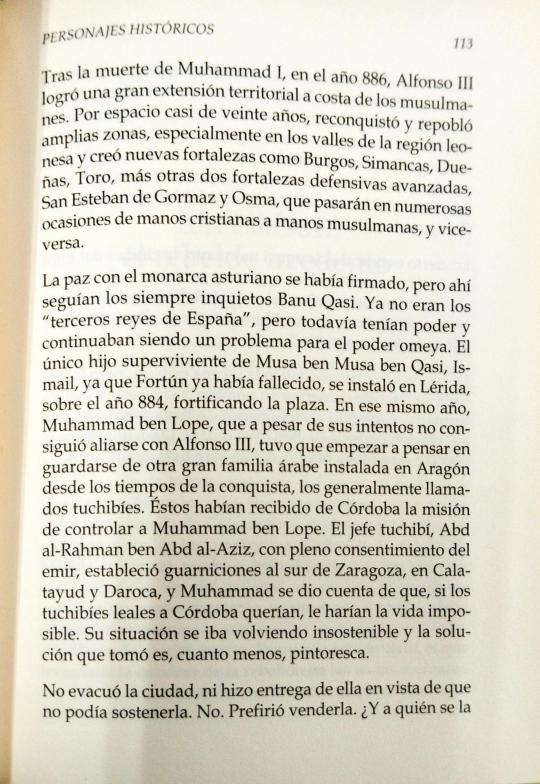
After the death of Muhammad I, in the year 886, Alfonso III achieved great territorial extension at the expense of the Muslims. For almost twenty years, reconquered and repopulated large areas, especially in the valleys of the Leonese region and created new fortresses such as Burgos, Simancas, Dueñas, Toro, plus two other advanced defensive fortresses, San Esteban de Gormaz and Osma, that will pass on numerous occasions from Christian hands to Muslims, and viceversa.
Peace with the Asturian monarch had been signed, but there were still the always restless Banu Qasi. They were no longer the "third kings of Spain", but they still had power and continued to be a problem for the Umayyad power. The only surviving son of Musa ben Musa ben Qasi, Ismail, since Fortun had already deceased, settled in Lleida, around the year 884, fortifying the stronghold. In that same year, Muhammad ben Lope, who despite his attempts did not manage ally with Alfonso III, had to start thinking about guarding against another great Arab family installed in Aragon since the times of the conquest, the generally called tuchibíes. These had received the mission from Córdoba to control Muhammad ben Lope. The Tuchibi chief, Abd al-Rahman ben Abd al-Aziz, with the full consent of the emir, established garrisons south of Zaragoza, in Cala-tayud and Daroca, and Muhammad realized that, if the tuchibís loyal to Córdoba wanted, they would make his life impossible. His situation was becoming unsustainable and the solution he took is, to say the least, picturesque.
He did not evacuate the city, nor did he surrender it since he could not sustain it. No. He preferred to sell it. And who did
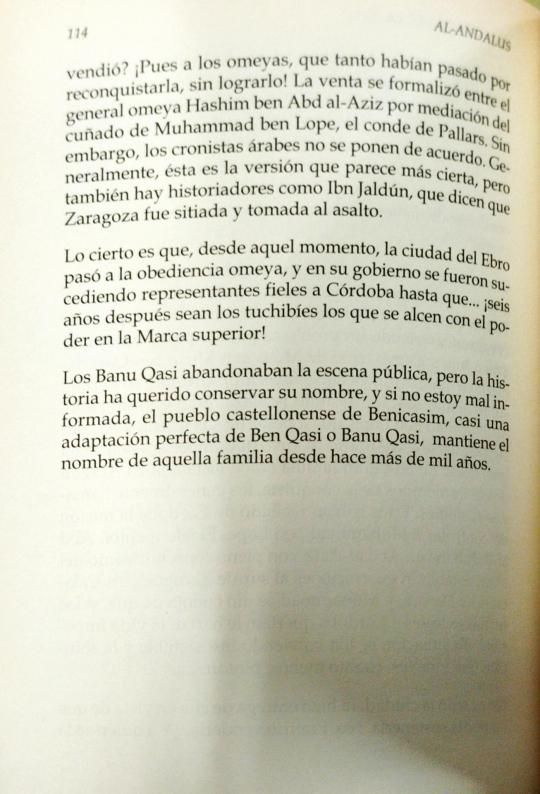
he sell It to? Well, to the Umayyads, who had gone through so much to reconquer it, without achieve it! The sale was formalized between the Umayyad general Hashim ben Abd al-Aziz through Muhammad ben Lope's brother-in-law, the Count of Pallars. However, the Arab chroniclers do not agree. Generally, this is the version that seems most true, but there are also historians like Ibn Jaldún, who say that Zaragoza was besieged and taken by storm.
The truth is that, from that moment, the city of the Ebro passed into Umayyad obedience, and in its government, representatives faithful to Córdoba succeeded until... six years later the Tuchibíes are the ones who rise to power on the Upper March!
The Banu Qasi left the public scene, but history has wanted keep their name, and if I am not misinformed, a town of Castellò, Benicasim, almost a perfect adaptation of Ben Qasi or Banu Qasi, maintains the name of that family for more than a thousand years.
#al andalus historical figures#al andalus personajes históricos#bookscans#bookblr#al andalus#al andalus history#historyblr#spanish history#banu qasi#musa ibn musa#emirate of cordoba#history#book scans
10 notes
·
View notes
Text
Se viene el Cosquin Rock 2025

El Cosquín Rock 2025 se llevará a cabo los días 15 y 16 de febrero en el Aeródromo de Santa María de Punilla, Córdoba. Esta edición es especialmente significativa, ya que marca el 25º aniversario del festival, consolidándose como uno de los eventos musicales más emblemáticos de Argentina.
Grilla de Artistas
El festival contará con más de 100 artistas distribuidos en siete escenarios, ofreciendo una mezcla de leyendas del rock nacional, bandas emergentes y representantes de géneros como el trap y la música electrónica. Entre los nombres más destacados se encuentran:
Los Piojos: Tras 15 años de inactividad, la banda liderada por Andrés Ciro Martínez regresa a los escenarios, siendo esta su primera presentación fuera de La Plata desde su reunión.
Divididos: Conocidos como "La Aplanadora del Rock", la banda de Ricardo Mollo y Diego Arnedo es una presencia infaltable en el festival.
Babasónicos: Pioneros del rock alternativo argentino, presentarán su más reciente material discográfico.
Wos: Uno de los referentes más destacados de la escena urbana actual, reconocido por su potente lírica y energía en el escenario.
Nicki Nicole: La artista rosarina debutará en el festival, llevando su mezcla de trap y R&B que la ha catapultado a la fama internacional.
Deadmau5: El reconocido DJ canadiense aportará su set de música electrónica, una de las sorpresas internacionales de esta edición.
Además, participarán otras bandas y artistas de renombre como Airbag, Las Pelotas, Skay y Los Fakires, No Te Va Gustar, Ratones Paranoicos, Las Pastillas del Abuelo, La Delio Valdez, El Mató a un Policía Motorizado, entre muchos otros.
Entradas y Accesos
Las entradas están disponibles a través del sitio oficial del festival: www.cosquinrock.net. Actualmente, se encuentra en venta la etapa denominada "Viajando", con opciones de pago en cuotas sin interés para tarjetas BBVA a través de MODO.
Para quienes asistan en vehículo particular, se ha habilitado un estacionamiento oficial con capacidad limitada, ubicado a pocas cuadras del ingreso al predio y de fácil acceso desde la ruta. Es recomendable reservar el lugar con anticipación.
Recomendaciones para los Asistentes
Clima: Según el pronóstico, se esperan condiciones climáticas variables durante el festival. El domingo 16 de febrero estará parcialmente soleado, con una temperatura máxima de 23°C y mínima de 15°C. El lunes 17 de febrero se prevén períodos de lluvias y tormentas eléctricas, con una máxima de 24°C y mínima de 14°C. Es aconsejable llevar ropa adecuada para estas condiciones, incluyendo impermeables y calzado cómodo.
Transacciones: Dentro del predio, todas las compras se realizarán mediante el sistema Pocket Cash, una pulsera con código QR que permite pagos en los puntos de venta. Se sugiere cargar saldo de forma anticipada a través de la web oficial para evitar filas y agilizar las transacciones.
Alimentación: Es posible adquirir comida de forma anticipada en la plataforma www.popmeals.net y retirarla directamente en el evento, lo que facilita la experiencia gastronómica durante el festival.
Seguridad y Salud: Mantenerse hidratado es esencial, especialmente considerando las posibles altas temperaturas. Utilizar protector solar y descansar en áreas sombreadas cuando sea necesario. Respetar las indicaciones del personal de seguridad y estar atento a los puntos de encuentro y salidas de emergencia.
El 25º aniversario del Cosquín Rock promete ser una edición memorable, no solo por la destacada grilla de artistas, sino también por las mejoras en la infraestructura y servicios para los asistentes. La combinación de bandas legendarias con nuevas propuestas musicales refleja la evolución del festival y su capacidad para adaptarse a las tendencias actuales, manteniendo su esencia y atractivo para diversas generaciones.
La inclusión de géneros como el trap y la música electrónica, junto con el rock tradicional, evidencia la diversidad y amplitud del festival, atrayendo a un público heterogéneo y enriqueciendo la experiencia cultural de los asistentes.
En resumen, el Cosquín Rock 2025 se perfila como un evento imperdible para los amantes de la música, ofreciendo una propuesta variada y de alta calidad en un entorno emblemático de la escena musical argentina.

1 note
·
View note
Text
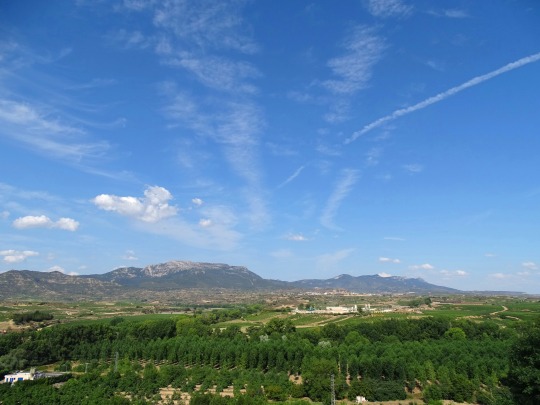









Wine Country, La Rioja (No. 1)
La Rioja is an autonomous community and province in Spain, in the north of the Iberian Peninsula. Its capital is Logroño. Other cities and towns in the province include Calahorra, Arnedo, Alfaro, Haro, Santo Domingo de la Calzada, and Nájera. It has an estimated population of 315,675 inhabitants (INE 2018), making it the least populated autonomous community of Spain.
It covers part of the Ebro valley towards its north and the Iberian Range in the south. The community is a single province, so there is no County Council, and it is organized into 174 municipalities. It borders the Basque Country (province of Álava) to the north, Navarre to the northeast, Aragón to the southeast (province of Zaragoza), and Castilla y León to the west and south (provinces of Burgos and Soria).
The area was once occupied by pre-Roman Berones, Pellendones and Vascones. After partial recapture from the Muslims in the early tenth century, the region became part of the Kingdom of Pamplona, later being incorporated into Castile after a century and a half of disputes. From the eighteenth century the Rioja region remained divided between the provinces of Burgos and Soria, until in 1833 the province of Logroño was created, changing the name of the province to La Rioja in 1980 as a prelude to its constitution under a single provincial autonomous community in 1982. The name "Rioja" (from Río Oja) is first attested in 1099.
The region is well known for its wines under the brand Denominación de Origen Calificada Rioja.
Source: Wikipedia
#Haro#wine country#La Rioja#Spain#San Vicente de la Sonsierra#travel#original photography#vacation#tourist attraction#landmark#cityscape#landscape#architecture#countryside#summer 2021#nature#flora#Northern Spain#Southern Europe#Ebro River#Davalillo Castle#España#vineyards#Bodegas Roda
3 notes
·
View notes
Text
Rickshaw Daycare
Spain
Andulusia
Talavera
Toledo
Granada
Cadiz
Cartagna
Cordoba
Albacete
Ubeda
Arcos
Arnedo
Ecjia
Seville
Elx
Burgos
Valencia
Badajoz
Pampolona
Alpuente
Teruel
Tuleda
Girona
Algeciras
Alcira
Jaen
Ronda
Ceuta
Zaragoza
Zamora
Simancas
Covadonga
Tarragona
Tortosa
Tarifa
Carmona
Calahorra
Cuena
Lleida
Merida
Malaga
Madrid
Sidonia
Melill
Moron
Najera
Guadalajara
Huesca
Huelva
Lucena
0 notes
Text
0 notes
Text
Les résultats du Vendredi 29 septembre : Corella, Arnedo, Algemesi, Guadarrama
Corella, Vendredi 29 septembre 6 toros de Guadalmena pourEl Cordobés : salut avec blessureEmilio de Justo : salut et 2 oreillesJoselito Adame : une oreille et une oreille Arnedo, Vendredi 29 septembre 6 novillos de Murteira Grave pourMario Navas : silence et silenceTristan Barroso : salut et une oreilleAlejandro Chicharro : une oreille et silence Algemesi, Vendredi 29 septembre 4 novillos de…

View On WordPress
#Alejandro Chicharro#Algemesi#Alvaro Seseña#Arnedo#Ayllon#Cuadri#Diego Lopez#El Cordobés#El Melli#Emilio de Justo#Fernando Guzman#Guadalmena#Guadarrama#Guillermo Garcia#Jarocho#José Maria Trigueros#Joselito Adame#La Campana#Mario Navas#Murteira Grave#Tristan Barroso#Victor Cerrato#Voltalegre
0 notes
Text
El hambre de David Gutiérrez destaca en la final del Zapato de Plata, que sale a oreja por coleta
Informa: Rosi Fernández Media entrada acogían los tendidos del Arnedo Arena este domingo en la segunda de la Feria de San José, una novillada sin picadores final del Zapato de Plata con Bombita, Diego Mateos y David Gutiérrez en el cartel. Dejó un variado saludo capotero Bombita al primero, al que quitó por gaoneras Mateos. … La entrada El hambre de David Gutiérrez destaca en la final del Zapato…
0 notes


